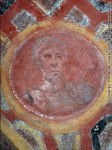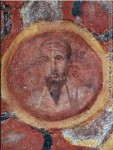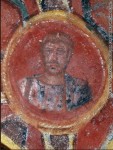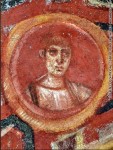 The oldest known images of apostles Andrew and John have been found under layers of white calcium deposits in the 4th century catacombs of St. Tecla in Rome.
The oldest known images of apostles Andrew and John have been found under layers of white calcium deposits in the 4th century catacombs of St. Tecla in Rome.
That’s the same catacomb where wall paintings of Saints Peter and Paul were discovered last year. There are earlier images of Peter and Paul extant, but only as part of group paintings. These are the earliest known solo portraits of Peter and Paul, and the portraits of Andrew and John predate the previous oldest-known representations by a century.
“John’s young face is familiar, but this is the most youthful portrayal of Andrew ever seen, very different from the old man with grey hair and wrinkles we know from medieval painting,” said project leader Barbara Mazzei.
Discovered in the 1950s and as yet unseen by the public, the St Tecla catacomb is accessed through the unmarked basement door of a drab office building, beyond which dim corridors packed with burial spots wind off through damp tufa stone.
They’re part of a group of elaborate, richly colored paintings which suggest the catacomb housed a noblewoman. The image of a bejeweled woman dressed in elegant clothing standing with her daughter between two saints is painted in one of the arches. Archaeologists believes she was the owner of the catacomb and patron of its arts.
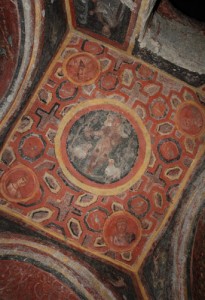 Besides the apostles, there are paintings of Christ as the Good Shepherd, a nude Daniel with lions at his feet, and Jesus raising Lazarus from the dead, Peter drawing water in the Mamertine prison, Mary and the three Wise Men, Abraham sacrificing Isaac, and more. The paintings are set against saturated red and black backgrounds, colors often associated with imperial Roman art.
Besides the apostles, there are paintings of Christ as the Good Shepherd, a nude Daniel with lions at his feet, and Jesus raising Lazarus from the dead, Peter drawing water in the Mamertine prison, Mary and the three Wise Men, Abraham sacrificing Isaac, and more. The paintings are set against saturated red and black backgrounds, colors often associated with imperial Roman art.
We wouldn’t know these colors existed if it weren’t for a new restoration technology. When archaeologists first opened the catacomb in 2008, the walls and ceilings were all covered in white. The closed and moist environment inside the catacomb created thick deposits of white calcium carbonate inches thick in some places. The incrustations were removed by a laser which can be calibrated by color, so archaeologists programmed it to remove only the white calcium carbonate. The laser stopped precisely at the colored paints which revealed the magnificent richness of the work without any fear of damaging it.
In the past restorers had to scrape the calcium off with brushes and scalpels. To ensure that they didn’t scrape off any of the paint, they had to keep a layer of white film obscuring the art. The laser procedure is just as painstaking, mind you, because they have to do it one pinpoint at a time, but the precision of the tool opens a whole new world of possibilities for restorers.
The four apostles are an unusual combination. Peter and Paul are together a lot, of course, especially in Rome where they both died, but Peter, Paul, Andrew and John don’t often get depicted together. The fact that all four were depicted in individual medallions around the central figure of Christ the Good Shepherd suggests that they were devotional icons, not just narratives, of the four most important apostles of the era. These paintings could well have been models for later representations; they lend insight into the dawn of apostle worship in early Christianity.
The catacombs will not be opened to the public — they are too delicate to cram hundreds of moist, secreting, respiring bodies into — but some the pontifical commission may allow the occasional small group to get a private tour.
